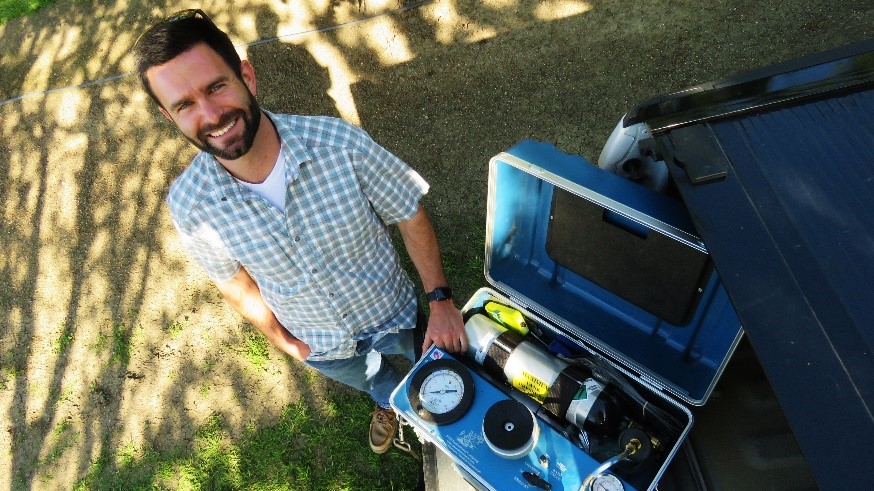Five years ago, Will Martin realized he couldn’t answer an important question about the orchard he managed: When and how much water do I run?
So he decided to find out.
 Will Martin, irrigation supervisor at Capay Farms in Orland, California, uses pressure chamber readings to ensure his water applications irrigate trees efficiently and effectively.
Will Martin, irrigation supervisor at Capay Farms in Orland, California, uses pressure chamber readings to ensure his water applications irrigate trees efficiently and effectively.
Since joining Orland-based Capay Farms as irrigation supervisor, Martin’s approach to answering that question has been methodical: focus on the fundamentals, use the right tools to gather information, analyze the data collected, measure performance and adjust decision-making accordingly.
Under the expertise of Martin, Capay Farms acts as a real-world example of a California almond orchard operating at the highest level of the Almond Irrigation Improvement Continuum. Developed by the Almond Board of California (ABC) in partnership with trusted and respected technical experts, the Continuum is a comprehensive manual of irrigation management and scheduling practices organized in three management levels: Level 1.0 (fundamental), Level 2.0 (intermediate) and Level 3.0 (advanced).
ABC recently sat down with Martin to discuss Capay Farms’ journey to achieving Continuum Level 3.0. He shared why the pressure chamber is his tool of choice, what advice he has for growers who are new to Continuum practices and why he focuses on the fundamentals of irrigation — Level 1.0 practices — which are within reach for all California almond growers.
ABC: What can you tell us about Capay Farms?
Martin: Capay Farms is an orchard management organization responsible for orchards in Glenn, Tehama, Butte and Colusa counties. We’re in our 30th year of business and we grow multiple varieties, such as Nonpareil, Carmel, Sonora, Mission and Butte. We also have a few Independence and Shasta varieties.
What are your responsibilities as irrigation supervisor?
I wear three hats here: 1) I manage the irrigation scheduling for our almond and walnut orchards. 2) I manage the maintenance and operation of our irrigation systems, as well as the designs for the new irrigation systems. 3) I manage our infield telemetry network, which collects readings for soil moisture, weather, pump system indicators and solar information. We use this data to try to make the best possible decisions for our trees.
What does your irrigation system look like today?
Currently, our irrigation system is 25% solid set sprinklers, 25% double-line drip and 50% microsprinkler. In our new orchards, our irrigation systems are a solid set PVC underground system, with one riser for every two trees and two microsprinklers per riser. The primary goal is to reduce labor. By having less of the system exposed, we should have fewer issues with rodents and coyotes damaging our lines. The underground system is also sized for frost protection, so we can take off the microsprinkler and put on a bigger sprinkler for better frost protection, which, as you can imagine, was important this year.
Tell us about your experience in getting to Level 3.0 of the Continuum.
When I started here five years ago, Capay Farms was already at Level 3.0 on several irrigation practices. They were using evapotranspiration rates, testing distribution uniformity of the system, using flow meters and taking soil moisture readings. However, they were operating at Level 1.0 relative to plant water status. The biggest question when I came here was “when and how much water do we run?” That led me to the pressure chamber.
What do you need to check before using a pressure chamber?
You have to look at the true fundamentals of an irrigation system. Was your irrigation system designed by an engineer? Was your pump matched to the irrigation system? When you’re running water, do you have the right pressure? What’s your actual distribution uniformity? If you have those things figured out, I personally go straight to the pressure chamber; it’s my tool of choice. People will say it’s labor intensive, but it’s the one thing that tells you how the tree is handling water. The pressure chamber gives you an actual reading of how stressed your trees are from irrigation. Then, using frequency and duration, you adjust your irrigation schedule to keep the trees in the “sweet spot.”
What are you missing if you’re not using a pressure chamber?
You are probably stressing the tree by under-irrigating or over-irrigating and you’re losing out on a longer growth period between irrigations. We’re trying to reduce the peaks and valleys of oversaturating and drying out the soil between irrigations.
Read Part II of ABC’s interview with Will Martin in the next edition of the California Almond Outlook.
____________________________________________________________________________
Not sure where to start or how your current practices compare to Continuum management levels?
Log in to your California Almond Sustainability Program (CASP) account at www.SustainableAlmondGrowing.org and complete the short Continuum assessment.
Don’t have a CASP profile? Sign-up is free and easy, providing access to helpful tools, such as nitrogen and irrigation calculators, and information about in-orchard best management practices.
Growers interested in learning more about the Almond Irrigation Improvement Continuum can also contact ABC’s Spencer Cooper, senior manager of irrigation and water efficiency, at scooper@almondboard.com or (209) 604-3727. Cooper’s one-on-one in-orchard consultation is free of charge and available to any California Almond grower. For more information, visit the Almond Board of California’s website at www.Almonds.com/Irrigation.